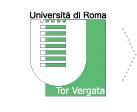University of Rome "Tor Vergata"
The University of Rome "Tor Vergata" is the second oldest public university in Rome, and among the largest in Italy. It was designed following the model of Anglo-Saxon universities and colleges, starter being operational in 1982. The University of Rome Tor Vergata is in the first 50 of the world’s top 50 universities established within the last 50 years.
Its campus stretches on an area of 600 hectares, which encompasses outstanding research institutions including CNR and ASI (the Italian Space Agency). The new International Centre for Fundamental and Applied Physics – the Nicola Cabibbo Laboratory – promoted by the National Institute for Nuclear Physics and the University of Rome "Tor Vergata" with a view to building the Super B accelerator, will also be included in the University compound. Thanks also to important research centres that operate in the University’s area, such as ENEA, ESA - ESRIN, the National Institute for Astrophysics, and the Monte Porzio Catone Observatory, "Tor Vergata" is one of the most dynamic universities and scientific centres in Italy. Tor Vergata owes its name to the ancient "Turris Virgate" country house (14th Century), owned by the Roman noble Annibaldi family, whose remains are now under the Gentile Villa, an old country house dating back to the 16th century, which was fully refurbished and is located within the University campus.
Today, Tor Vergata offers 114 courses (including bachelor, master, and single-cycle bachelor and master courses), 9 of which are entirely taught in English. The university takes part in International research projects and promotes multi-disciplinary research. It has established close links with Italian businesses and promotes the starting up and growth of businesses stemming from the world of research, with a view to developing innovative products.
Tor Vergata also has 1500 students dorms.
One of the most modern Italian hospitals – Policlinico Universitario Tor Vergata – is also located within the university compound. It is an outstanding healthcare and research centre covering the whole Lazio Region, and featuring state-of-the-art equipment. The University’s School of Medicine is also linked to the hospital.
Through its International Division, the University intends to be a focal point for European and non-European cross-cultural integration and evolutionary processes. In such a framework, it promotes, develops, and runs bilateral and multilateral research-teaching cooperation programmes. “Tor Vergata” aims at becoming part of the most distinguished worldwide network of institutions producing and spreading knowledge and research, building on its high academic and scientific standards achieved during the past three-year internationalization process, which will continue through teacher and student exchange programmes, the organisation of workshops, conferences, summer schools, and joint research activities.
Some key figures
(2012-2013 data)
- 40,000 students (including post-graduate)
- 1441 teachers (including researchers)
- 1021 technicians and admin staff
- 600-hectare campus
- 6 Schools (Economcs, Law, Engineering, Arts and Humanities, Medicine, Sciences)
- 114 courses
- 144 post-graduate and Master courses
- 41 post-graduate schools
- 300 five thousand euro yearly scholarships for the best graduate students
- 30 computer posts sto register online
- 19 departments
- 31 PhD curses
- 330 research allowances awarded every year
- 6 libraries
- 1000 internships launched every year
- 475 student exchanges
- 554 Erasmus scholarships awarded every year
- 75 Leonardo scholarships
- 40 five hundred Euro placement scholarships for (average) 4 months
